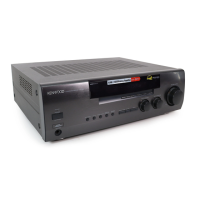
Do you have a question about the Kenwood VR-309 and is the answer not in the manual?
| Channels | 5.1 |
|---|---|
| Frequency Response | 10 Hz - 50 kHz |
| Total Harmonic Distortion | 0.08% |
| Input Sensitivity | 200 mV (Line) |
| Weight | 8.5 kg |
| Rated Output Power (8 ohms, 20 Hz - 20 kHz, 0.08% THD) | 100 W |
| Input Impedance | 47 kOhm |
| Digital inputs | Coaxial, Optical |
| Video Connections | composite |
| Power Output | 100 W per channel (8 ohms, 20 Hz - 20 kHz, 0.08% THD) |
| Speaker load impedance | 6 - 16 ohms |
| Speaker Impedance | 6 - 16 ohms |
Details essential warnings to prevent fire, electric shock, and ensure safe operation and servicing.
Details special audio technologies like DTS, Dolby Digital, Pro Logic, and Virtual Surround for enhanced playback.
Provides diagrams and instructions for connecting various audio devices like CD players, cassette decks, and record players.
Guides on connecting video sources like DVD players, LD players, and video decks using S-Video and composite video.
Details connecting DTS, Dolby Digital (AC-3), or PCM digital audio signals using optical or coaxial cables.
Provides step-by-step instructions and diagrams for connecting front, surround, and subwoofer speakers, including banana plug usage.
Offers guidance on placing front, center, surround speakers, and subwoofer for the best surround sound experience.
Guides through setting up speaker configurations (subwoofer, front, center, surround) for optimal surround sound performance.
Explains how to adjust speaker volumes using test tones to achieve balanced sound output.
Details how to measure and input the distance from the listening position to each speaker for accurate sound processing.
Explains how to adjust the bass and treble levels for PCM stereo and analog stereo audio.
Explains AUTO REC MODE and MANUAL REC MODE for digital audio sources, highlighting differences.
Details the process of storing favorite radio stations into memory presets and recalling them.
Explains Dolby Digital (AC-3) surround sound, its benefits, and speaker setup requirements.
Details the DTS surround sound format, its digital nature, and connection requirements for optimal playback.
Provides instructions for resetting the microcomputer to resolve malfunctions or erroneous displays.
Lists common amplifier and tuner symptoms, their causes, and remedies for various operational problems.
Lists detailed technical specifications for the receiver's audio output, input sensitivity, and tuner performance.